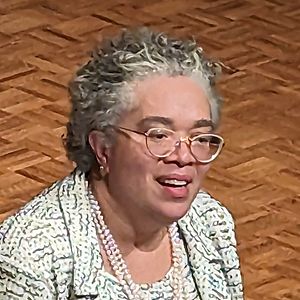G. Gabrielle Starr facts for kids
Quick facts for kids
Gina Gabrielle Starr
|
|
|---|---|

Starr in 2023
|
|
| 10th President of Pomona College | |
| Assumed office July 1, 2017 |
|
| Preceded by | David W. Oxtoby |
| Personal details | |
| Born | 1974 (age 50–51) Tallahassee, Florida, U.S. |
| Spouse | John C. Harpole |
| Children | 2 |
| Education | Emory University (BA, MA) University of St Andrews Harvard University (PhD) |
| Profession | Academic |
| Scientific career | |
| Institutions | |
| Thesis | The frame of sense: The epistolary novel and the lyric mode in eighteenth-century England (1999) |
| Doctoral advisor |
|
Gina Gabrielle Starr, born in 1974, is an American scholar and university leader. She is currently the 10th president of Pomona College. This is a special type of university called a liberal arts college in Claremont, California.
Starr is well-known for her studies in 18th-century British literature. She also researches the neuroscience of aesthetics, which is how our brains understand beauty. She has received important awards like a Guggenheim Fellowship. She was also given an ADVANCE award from the NSF. Another award she received was a New Directions Fellowship from the Mellon Foundation.
Before leading Pomona College, she taught at New York University from 2000 to 2017. In 2017, she made history. She became the first woman and the first African-American president of Pomona College. In 2020, she was chosen to be a member of the American Academy of Arts and Sciences. In 2024, she joined the American Philosophical Society.
Early Life and Education
Gina Starr grew up in Tallahassee, Florida. She started college at Emory University when she was only 15 years old. There, she earned two degrees in women's studies by 1993. These were her bachelor's degree (BA) and her master's degree (MA).
After Emory, she studied in Scotland at the University of St Andrews. She was a Robert T. Jones Scholar there. Later, in 1999, she earned her Ph.D. (a very high-level degree) in English literature from Harvard University.
Career Highlights
After getting her Ph.D., Dr. Starr decided to learn about cognitive neuroscience. This field studies how our brains think and learn. She received a special fellowship from the Andrew W. Mellon Foundation to do this. She then completed a research program at the California Institute of Technology. There, she explored new methods in cognitive neuroscience.
In 2000, she joined the teachers at New York University (NYU). She became the acting dean (a leader) of the College of Arts and Science in 2011. By 2013, she became the full dean.
In 2015, Dr. Starr helped start a special education program. This program offered liberal arts classes to people in prison at Wallkill Correctional Facility in New York. She also worked with the Borough of Manhattan Community College. Together, they created a program called P.O.I.S.E. This program helped promising students prepare for and transfer into STEM (Science, Technology, Engineering, and Math) bachelor's degree programs at NYU. It offered support, guidance, and financial help.
In 2016, she was chosen to be the 10th President of Pomona College. She officially started this important job on July 1, 2017. During her time as president, she led the college's efforts to deal with the COVID-19 pandemic. She also supports affirmative action, which aims to create fair opportunities for everyone. As of 2020, her yearly pay was valued at $686 thousand.
Research and Discoveries
Dr. Starr's research combines different fields of study. She brings together literary scholarship, which is the study of books and writing, with psychology and cognitive neuroscience. Her work looks at how our brains experience beauty.
Her book, Feeling Beauty, suggested a way to understand aesthetic experience. It explained that different parts of our brain work together when we find something beautiful. This book was recognized for an award in 2014. Her newer book, Just in Time, continues this research. It suggests that what we expect from art, combined with how challenging the art is, affects how long we experience beauty and which brain systems are involved.
She uses a special brain scanning technique called functional magnetic resonance imaging (fMRI). This helps her see which parts of the brain are active during aesthetic experiences. Her research has shown that a brain network called the default mode network is involved in how we feel about beauty. She has published her findings in many science journals. These include Modern Philology, Eighteenth-Century Fiction, Eighteenth-Century Studies, Proceedings of the National Academy of Sciences, Cognition, Neuron, NeuroImage, and Psychology of Aesthetics, Creativity, and the Arts.

